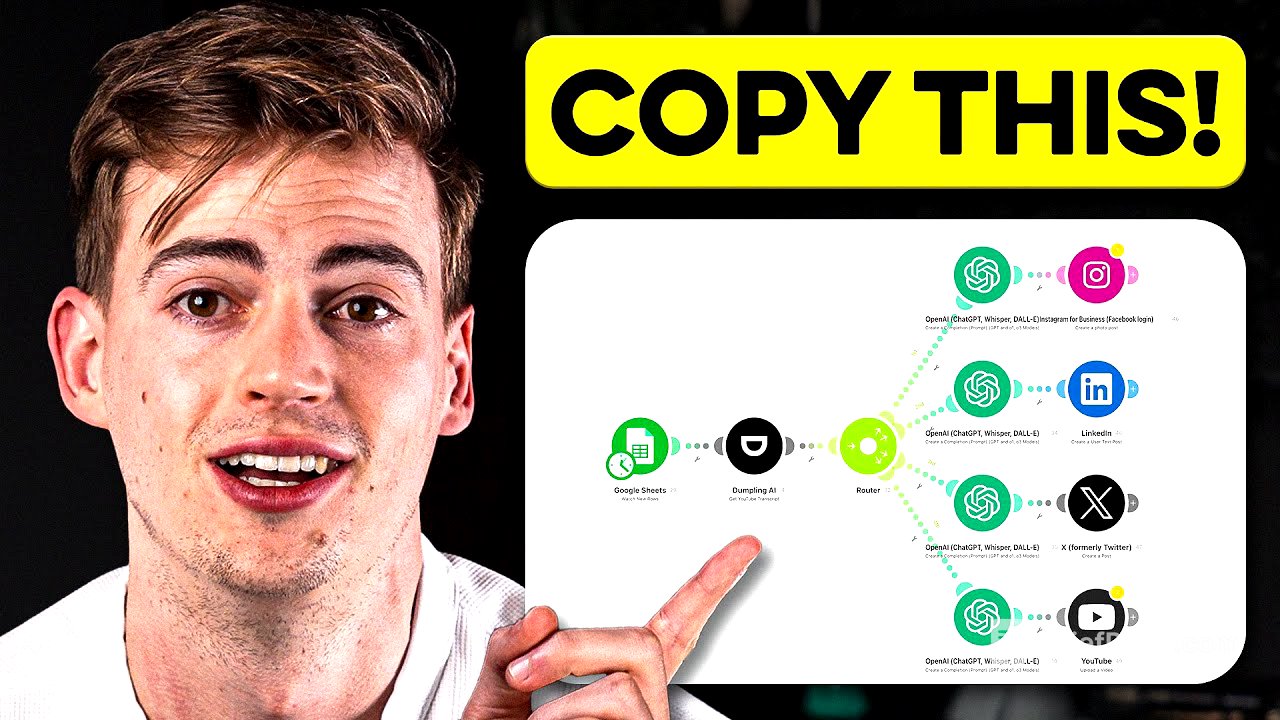TLDR;
This video provides a comprehensive guide on how to automate social media content creation and posting using AI tools and make.com. It covers setting up the automation, connecting various accounts (Instagram, LinkedIn, X, YouTube), and using AI to generate scripts, images, and even create AI clone videos. The process involves copying a pre-built automation blueprint, connecting accounts, and using AI tools like Dumpling AI and ChatGPT.
- Automate content creation and posting across multiple social media platforms.
- Use AI to generate scripts, images, and AI clone videos.
- Integrate tools like make.com, Dumpling AI, and ChatGPT for a fully automated process.
Introduction to Social Media Automation [0:00]
The video introduces an automation process that handles social media content creation and posting across platforms like Instagram, LinkedIn, X, and YouTube. This automation eliminates the need for manual content creation and posting, offering a hands-free solution. The presenter claims the setup is simple enough for anyone to follow, even those with limited technical experience.
Setting Up the Automation with make.com [1:23]
To begin, the presenter instructs viewers to make a copy of the provided document to gain editing access. Next, viewers need to sign up for make.com and copy the automation blueprint provided in the video description. This involves downloading the blueprint file, creating a new scenario in make.com, and importing the downloaded blueprint. The presenter emphasizes that further steps are required, such as copying prompts and linking accounts, to fully activate the automation.
Connecting Google Sheets for Content Input [2:22]
The next step involves copying a Google Sheets spreadsheet that is connected to the automation. Viewers are instructed to make a copy of the provided spreadsheet for their personal use. Within make.com, users need to connect their Google Drive account and locate the copied spreadsheet, specifying the sheet name ("new sources") and confirming that the table contains headers. The spreadsheet is used to input YouTube video URLs, which the automation then uses to generate content. The presenter prefers using YouTube videos as input because they provide detailed explanations of products, particularly in the AI field.
Integrating Dumpling AI for Transcript Generation [5:00]
The video explains how to connect a Dumpling AI account for free to generate video transcripts. Users need to sign up on the Dumpling AI platform, create a new secret API key, and copy this key into make.com. The URL from Dumpling AI is entered, and settings are adjusted to exclude timestamps and set the preferred language to English. Dumpling AI is used to get the transcript of the YouTube video provided in Google Sheets.
Configuring Social Media Account Integrations [6:02]
The video details how to set up integrations for various social media platforms, including Instagram, LinkedIn, X (Twitter), and YouTube. The process involves using a router in make.com to send the generated transcript to different GPT models. Users need to connect ChatGPT by adding their API key, obtained from the OpenAI platform, to make.com. The presenter recommends using the GPT-4.0 model for optimal performance.
Setting Up GPT Bots and Prompts [7:08]
The presenter explains how to set up the first GPT bot by selecting the GPT-4.0 model and adding a balance to the OpenAI account. Users are directed to copy specific prompts from the provided spreadsheet and paste them into the chat within make.com. These prompts are tailored for each social media platform (LinkedIn, X) to generate appropriate content. The transcript from Dumpling AI is then added to the end of each prompt.
Image Generation and Instagram Integration [9:17]
The video discusses image generation for Instagram, using either ChatGPT's DALL-E 3 or Dumpling AI with Recraft, Flux, or Flux Pro. Users need to connect their Instagram account through a Facebook business account and select their page. The generated image URL from DALL-E is then linked to Instagram, and the generated caption is added. The presenter notes that LinkedIn follows a similar process.
Configuring X (Twitter) Integration [10:42]
The presenter describes the more complex process of integrating X (Twitter) due to the platform's less straightforward API. Users are directed to a specific website and video tutorial that explain the necessary steps to connect their Twitter account. Once connected, the generated results are added to the automation.
Automating YouTube Shorts with an AI Clone [11:29]
The final step involves creating automated YouTube Shorts using an AI clone. The presenter references a previous video that provides an in-depth explanation of this process. Key changes include using a different prompting style with the 01 mini model and connecting a HeyGen account with its API. The automation also includes a new feature to generate video titles using ChatGPT, which are then used when uploading the video to YouTube.
